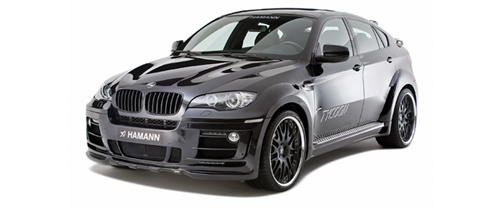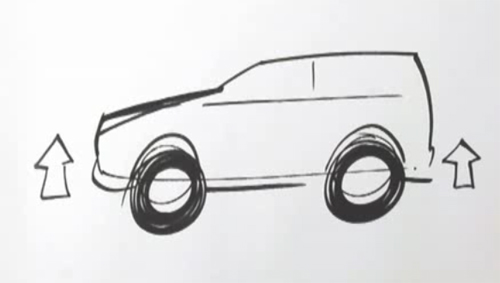 BMW is ready to tackle the 2009 Formula One season with a new, KERS-equipped BMW Sauber F1 racer. Full details and the stunning gallery below.
BMW is ready to tackle the 2009 Formula One season with a new, KERS-equipped BMW Sauber F1 racer. Full details and the stunning gallery below.
The new BMW 2009 Formula One entrant is strikes a clear visual difference from its predecessor in the three-element nose on the F1.09 car, which is higher and larger than the previous generation. On the other end, the rear wing has gotten much smaller because of new regulations.
Despite the overwhelming visual presence, the Kinetic Energy Recovery System (KERS) is probably the biggest story of the new car. The new system, which collects energy from braking, will be able to supply an extra 80 HP for a period of about 6.67 seconds at the push of a button. This system will allow for better passing, or so the theory goes.
Of course, at the launch BMW team leader Mario Theissen said he wasn't sure they're ready to use the system. Whatever happens with the car, expect it's performance to be shocking.
The BMW Sauber F1.09 – fundamentally different.
The winds of change are blowing through Formula One. 2009 sees arguably the
most significant rewrite of the F1 technical rulebook in the history of the sport.
Whereas up to now the engineers had always been able to use the previous
year’s car as a basis for the design of their new machine, now they’ve been asked
to start with a clean slate – or, more accurately, a blank computer screen.
Completely redefined aerodynamics, the return of treadless tyres (slicks) and the
option of fitting KERS (Kinetic Energy Recovery System) technology have
literally brought the teams back to the drawing board.
In early 2007 the FIA set up the OWG (Overtaking Working Group) to think up
ways of making Formula One more attractive; in other words, to identify areas
where change was needed to make overtaking easier.
The principle problem of modern Formula One cars lay in the massive
amounts of downforce they lost once the distance to the car in front dropped
below around two seconds. This “dirty air” whipped up by the preceding car
significantly diminished the effect of the front wing in particular, and this
manifested itself in pronounced understeer. As a result, changes in position
were more frequently the result of strategies in the pit lane than overtaking
manoeuvres out on the track.
The OWG looked into this phenomenon with the help of a series of
experimental tests in the wind tunnel and computer-aided airflow simulations,
before coming up with a proposal: less aerodynamic downforce combined
with more mechanical grip would be the way ahead. Indeed, the OWG
recommended reducing downforce by some 40 percent.
This has led to radical changes, especially as far as aerodynamics are
The BMW Sauber F1.09 – fundamentally different.
The winds of change are blowing through Formula One. 2009 sees arguably the
most significant rewrite of the F1 technical rulebook in the history of the sport.
Whereas up to now the engineers had always been able to use the previous
year’s car as a basis for the design of their new machine, now they’ve been asked
to start with a clean slate – or, more accurately, a blank computer screen.
Completely redefined aerodynamics, the return of treadless tyres (slicks) and the
option of fitting KERS (Kinetic Energy Recovery System) technology have
literally brought the teams back to the drawing board.
In early 2007 the FIA set up the OWG (Overtaking Working Group) to think up
ways of making Formula One more attractive; in other words, to identify areas
where change was needed to make overtaking easier.
The principle problem of modern Formula One cars lay in the massive
amounts of downforce they lost once the distance to the car in front dropped
below around two seconds. This “dirty air” whipped up by the preceding car
significantly diminished the effect of the front wing in particular, and this
manifested itself in pronounced understeer. As a result, changes in position
were more frequently the result of strategies in the pit lane than overtaking
manoeuvres out on the track.
The OWG looked into this phenomenon with the help of a series of
experimental tests in the wind tunnel and computer-aided airflow simulations,
before coming up with a proposal: less aerodynamic downforce combined
with more mechanical grip would be the way ahead. Indeed, the OWG
recommended reducing downforce by some 40 percent.
This has led to radical changes, especially as far as aerodynamics are
concerned. The front wing of the F1.09, for example, has grown in width from
1,400 mm to 1,800 mm, making it as broad as the car as a whole. It is also fixed
lower down than before. Added to which, spectators will find the significantly
narrower, higher-mounted rear wing takes some getting used to.
The regulations have also limited the use of air deflectors and cooling apertures
to a minimum. The result of all these new rules is a totally new look for the
F1 cars.
Even more exciting than ever.
For Willy Rampf, the BMW Sauber F1 Team Technical Coordinator and the
man responsible for the concept of the BMW Sauber F1.09, and Walter Riedl,
Managing Director of BMW Sauber AG – who also heads up the technical
department in Hinwil and is responsible for the development of the new car –
this project has represented a memorable challenge. “Developing a new
Formula One car is always exciting, but this time there was something even
more special about it. We really were starting from scratch,” says Rampf.
The combination of the return of slicks with the possible use of KERS
technology places particular importance on weight distribution. “First and
foremost, the switch from grooved tyres to slicks means more grip, of course,
but it also moves the balance of forces further forward: removing the grooves
gives the front tyres proportionally a greater contact area and more grip than
the rear tyres,” explains Rampf. Consequently, more weight has to be shifted
towards the front of the car and the aero balance adjusted likewise.
This is no easy task, especially in conjunction with KERS, as the new system
adds extra weight and the engineers have much less scope for juggling ballast.
Furthermore, they also have to find a way of packaging the KERS elements –
the electric motor/generator, energy storage unit and control unit – which mini-
mises their negative impact on aerodynamics and at the same time ensures
there is sufficient cooling for all these components.
Work begins earlier than usual.
The team had to carefully consider all of these practical constraints in the basic
concept of the car. Key areas included the definition of parameters such as
the wheelbase, weight distribution, position of the engine and gearbox, shape
and size of the fuel tank, and the positioning of the KERS elements. “Because
the car differs so significantly from its predecessor, we already started work
on the first concept studies in February – two months earlier than normal and
before the F1.08 had even started its first race,” says Rampf, highlighting
the extraordinary nature of the situation.
“Our aim,” continues Rampf, “was to build a car with high aerodynamic
efficiency and in so doing claw back as much of the downforce as possible,
which the new regulations had taken away.” The first phase of the project
involved conducting studies on several different concepts in which the team
assessed the interplay of aero balance, tyre requirements and weight
distribution. This was followed by an optimisation phase.
The aerodynamics experts invested a great deal of time in the development of
the front wing in particular, as this area influences the airflow over the entire car.
As far back as February, the BMW Sauber F1 Team specialists used CFD –
and therefore the capability of the Albert3 supercomputer – to look into the
functioning of the front wing and, more specifically, its interaction with the
underbody. “No longer being allowed to use turning vanes to guide the airflow
makes the task a whole lot more difficult,” explains Walter Riedl. Another
complicating factor is the centre section of the front wing, which is also
precisely defined in the regulations and thus imposes further constraints on
how much the engineers can do.
The result is a three-element front wing with a very dominant visual presence,
which does much to shape the appearance of the car as a whole. Its outer
edges are fitted with several auxiliary elements, which are all designed to
channel the air as efficiently as possible around the front tyres. The less air
hitting the turning wheels directly, the less uncontrolled turbulence occurs.
Another new feature of the regulations allows the drivers to move the flaps on
the front wing upwards or downwards. Again, this is intended to make it easier
to get up close behind the car in front.
They may have already made admirable progress, but this is just the beginning
for the engineers, as Riedl explains. “The complexity inherent in the interaction
of the front wing with the open front tyres means there is still a lot of potential
for further development here. Indeed, we picked up a wealth of valuable
knowledge in this area with the F1.08.”
The nose of the car also reveals striking changes and is now considerably
higher and, above all, much wider than its predecessors. After a large number of
tests, this variant proved to be the most efficient when working in combination
with the new front wing.
Severe demands on cooling.
The new regulations have also presented the engineers with a challenge when
it comes to the car’s cooling concept, as lamellar outlet vents in the engine
cover are no longer permitted. For this reason, at the rear of the car the air now
flows back centrally through the aperture between the engine cover and the
gearbox. The channelling of the airflow takes on particular importance here, as
the hot air heats up all the nearby components. Where you used to be able to
vary the level of cooling through chimneys and lamellar outlet vents of different
sizes, now you can only vary the size of the air outlets.
But that’s not all, since the KERS elements also need to be cooled. While the
energy storage units fitted with impressive compactness in the two sidepods
are kept within the required temperature band by the flow of air, the KERS
control unit, which is fitted in the right-hand sidepod, has an integrated cooling
system.
The sidepods are high at the front and do not fall away as sharply to the rear as
in previous years. As chimneys or lamellar outlet vents may no longer be used
as an escape route for the exhaust air, the whole rear area of the car, including
the engine cover, has to increase in volume to enable optimum airflow over this
section as well.
The rear wing is totally new in terms of both its form and its position. It now
measures only 750 mm in width – instead of 1,000 mm, as on last year’s car –
but is 950 mm in height, up from the previous 800 mm. This change in the
regulations means that cars following behind will be subjected to less
turbulence. A particularly striking feature are the side endplates, whose form
has a major influence on the optimum functioning of the rear wing.
The lower levels of downforce will have an effect on the car’s aerodynamic
set-up. “In 2009 we’ll be running maximum downforce at a lot more circuits
than last season,” says Rampf.
Something the observer will not be able to spot at first glance are the changes
to the diffusor also specified in the regulations. This element now rises over
a longer area than before and leads further back along the car. As a result there
will no longer be direct interaction between the diffusor and the lower element
of the rear wing, which will make the car less sensitive to different airflows.
Making optimum use of tyre potential.
The switch to slick tyres was a central factor in the development of the car’s
suspension. The team collected initial data with the grooveless tyre, which
generates far greater grip than its predecessor, over the course of the summer
after Bridgestone delivered the first batch of slicks for testing. It quickly became
clear that achieving the right weight distribution would play a critical role. At the
front axle the priority was to extract the full potential from the tyre in the various
situations. Plus, optimised kinematics and high rigidity should allow it to give
the driver high-quality feedback.
Whereas the front axle for the new car shows only minor differences to the one
fitted on the F1.08, the rear axle is an all-new design adapted to the changes in
tyre characteristics. The aim was to achieve excellent traction, while at the same
time exploiting the lateral force potential of the tyres through an extremely wide
band. Added to which, the F1.09 should retain the impressive braking stability
of its predecessor.
And, of course, the engineers also placed considerable importance on keeping
the weight of the new car as low as possible. Numerous components were
further optimised to this end. There were no compromises, however, when it
came to rigidity.
“The development of the F1.09 centred on three key areas: aerodynamics,
optimum tyre utilisation and the integration of KERS. That’s where our focus
has been from the outset and where we have channelled the large reserves
of knowledge amassed during the course of last season. The F1.09 contains
the combined expertise of a highly motivated team – one which will be pulling
out all the stops to fulfil our ambitious aims once again in our fourth year on
the F1 grid,” sums up Managing Director, Walter Riedl.
[Source: BMW]
Read more...







 BMW is ready to tackle the 2009 Formula One season with a new, KERS-equipped BMW Sauber F1 racer. Full details and the stunning gallery below.
BMW is ready to tackle the 2009 Formula One season with a new, KERS-equipped BMW Sauber F1 racer. Full details and the stunning gallery below.





 Welcome to Down On The Street, where we admire old vehicles found parked on the streets of the Island That Rust Forgot: Alameda, California. Here's an example of one of BMW's best-looking designs.
Welcome to Down On The Street, where we admire old vehicles found parked on the streets of the Island That Rust Forgot: Alameda, California. Here's an example of one of BMW's best-looking designs.


































